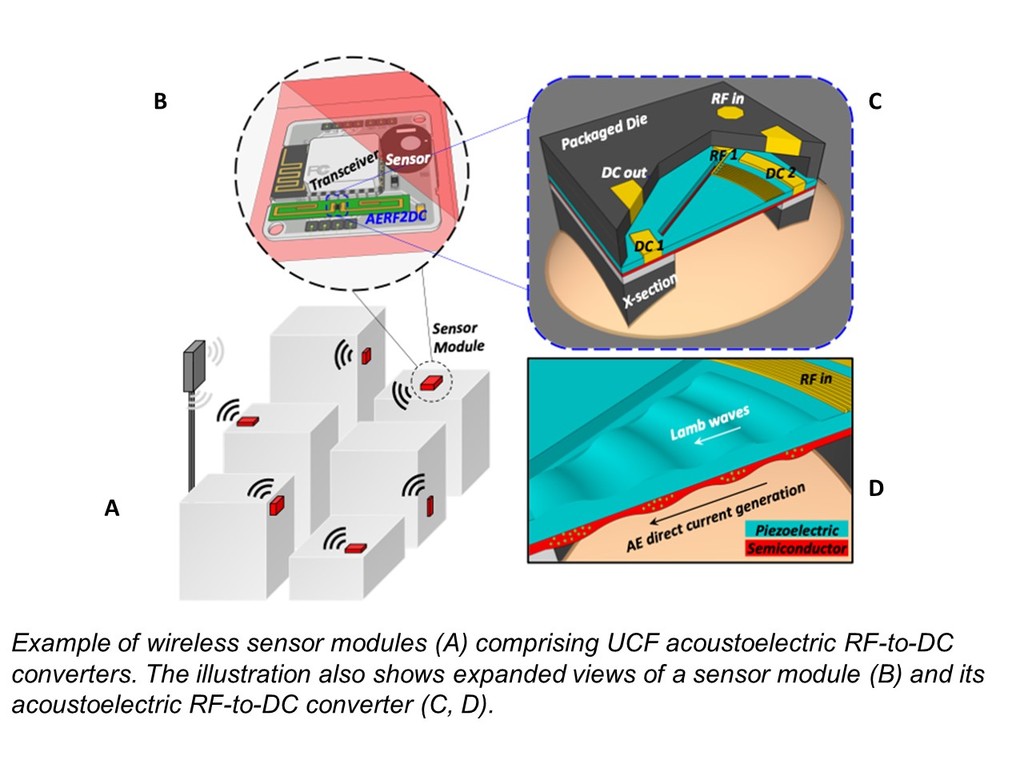Our busy urban spaces are already crowded and crammed with a whole manner of machines, people and buildings — resulting in sprawling concrete jungles. But the air itself is also filled with invisible informational traffic. Wifi signals, radio waves and telecommunications are constantly crisscrossing our environment – and now a new approach is looking to harvest them for power.
A research team at the University of Central Florida’s Department of Electrical and Computer Engineering have developed a new prototype system which can use the otherwise wasted electrical potential of radio frequencies. In particular radio frequency electromagnetic waves — the most abundant in most populated areas — have the potential to power ultra-low powered devices without the need for batteries or even sensors.
To harvest this power, the UCF device makes use of piezoelectric materials — which generate an electrical charge through mechanical stress on solid objects. These stresses can be as subtle as minor vibrations in the air, and it has long been theorised that radio waves or sound waves can also be used to generate a charge in some devices. The UCF invention, in particular, takes advantage of the energy exchange mechanism between microacoustic waves (the basis for most of radio frequency signal processing) and electrons.
Radio frequencies, and their microacoustic waves are detected by the device and passed over a piezoelectric material placed upon a semi-conductor. The effect of the waves upon the material generates a current which is converted into direct current for use by the attached device.
One issue that has limited the practicality of using radio waves as a source of power, is the requirement to sense and transmit signals which require power. To solve these issues, the UCF researchers have developed a technology that integrates power scavenging and spectrum sensing capabilities into a passive module. This would therefore eliminate the need for power-intensive sensing modules. It would also be possible to store this energy into a capacitor or battery if required.
Another issue concerns the availability of the radio spectrum needed to generate power. The conversion occurs within a sub-millimeter radio wave footprint, and within a specifically defined frequency range. To tackle this problem, the device has also been developed to handle more ‘intelligent’ data transmissions between smart Internet of Things nodes and understand the occupancy of frequencies in the area.
In layman’s terms, this would allow a device to scavenge energy from the radio frequency power emitted from nearby IoT nodes.
The concept is especially geared towards powering low-powered IoT sensors and devices — especially in an urban environment. The requirement for power — either from a solar panel or onboard battery — places practical limitations on these devices. Solar panels must be a certain size and have constant access to sunlight, something which is not guaranteed in urban areas with tall buildings. Meanwhile, batteries need to be changed and add extra expense. In theory, a device harvesting power from radio waves could generate power more consistently and at a reduced cost in terms of maintenance and construction.
Currently, a prototype has been constructed by the team, and they are now seeking partners for production.
No Wires Attached
Although transmitting power wirelessly may seem highly advanced technology, it has long been considered and experimented with. Nikolai Tesla theorised such technology, and it came to fruition in the 1960s with the rectenna — a compound of ‘rectifying’ and ‘antenna’.
Today, rectennas are largely used in radio frequency identification tags, like those used in logistics, passports and animal tracking. These barcode-like devices do not need line-of-sight with a scanner to function, and can be temporarily powered when in the presence of certain radio waves. Other applications include proximity and contact smart cards.
However, radio wave power transfer is also being discussed as a way of potentially beaming solar energy from space, or for consistently powering vehicles such as drones.
The post Radio Wave Power: New Technology Generates Power from Radio Frequencies appeared first on Digital for Good | RESET.ORG.


